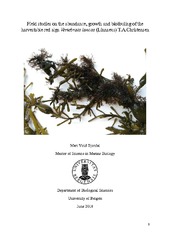| dc.contributor.author | Bjordal, Mari Vold | |
| dc.date.accessioned | 2018-08-13T14:52:43Z | |
| dc.date.available | 2018-08-13T14:52:43Z | |
| dc.date.issued | 2018-08-10 | |
| dc.date.submitted | 2018-08-09T22:00:12Z | |
| dc.identifier.uri | https://hdl.handle.net/1956/18055 | |
| dc.description.abstract | Macroalgae have an important ecological role as primary producers and habitat engineers for fauna in coastal areas, and many species can also be used for human consumption. Like vegetables, macroalgae contain essential vitamins and minerals, and red algae can also contain large amounts of protein. Vertebrata lanosa is a small red alga and an obligate epiphyte on seaweed. It grows almost exclusively on knotted wrack, Ascophyllum nodosum, which is commonly found in sheltered, upper intertidal habitats. With the exception of the Baltic sea and Greenland, V. lanosa is distributed along the coasts of the North Atlantic Ocean. The alga has lately received culinary attention in Scandinavia for its truffle-like taste and has been given the nickname “truffle of the sea”. This study has focused on distribution, growth and biofouling to gain valuable knowledge related to harvest of V. lanosa. 27 locations South of Bergen were included in an abundance study of both V. lanosa and its host A. nodosum, where physical factors as exposure, geographical orientation, temperature, salinity, inclination and vertical position in the tidal zone were assessed. V. lanosa was more abundant in areas of relatively high exposure and inclination and less abundant in more sheltered and flatter areas with large canopies of A. nodosum. This is likely due to increased physical impact on A. nodosum fronds at exposed sites which results in wounds and scratches. Damaged areas on the fronds of A. nodosum have higher settlement and survival of V. lanosa spores, likely due to favourable hydrodynamic conditions and limited epidermal shedding in wounded areas which increase the chance of rhizoid anchoring by V. lanosa. In total, 19 different epiphytic species were identified growing on V. lanosa, and the number and size of epiphytes were substantially higher in November than in February, suggesting that late winter and early spring is the best harvest time to ensure a clean product. For further studies, the growth of V. lanosa needs to be assessed in more detail and over longer time periods to gain knowledge on how to harvest the alga sustainably. | en_US |
| dc.language.iso | eng | eng |
| dc.publisher | The University of Bergen | en_US |
| dc.subject | fouling | eng |
| dc.subject | Vertebrata lanosa | eng |
| dc.subject | food algae | eng |
| dc.subject | sustainable harvest | eng |
| dc.subject | Ascophyllum nodosum | eng |
| dc.subject | edible algae | eng |
| dc.subject | macroalgae | eng |
| dc.subject | Makroalger | nob |
| dc.subject | Påvekst | nob |
| dc.subject | Spiselige alger | nob |
| dc.title | Field studies on the abundance, growth and biofouling of the harvestable red alga Vertebrata lanosa (Linnaeus) T.A.Christensen | en_US |
| dc.type | Master thesis | |
| dc.date.updated | 2018-08-09T22:00:12Z | |
| dc.rights.holder | Copyright the Author. All rights reserved | en_US |
| dc.description.degree | Masteroppgave i biologi | en_US |
| dc.description.localcode | MAMN-BIO | |
| dc.description.localcode | BIO399 | |
| dc.subject.realfagstermer | https://data.ub.uio.no/realfagstermer/c006200 | |
| dc.subject.realfagstermer | https://data.ub.uio.no/realfagstermer/c032043 | |
| dc.subject.realfagstermer | https://data.ub.uio.no/realfagstermer/c031465 | |
| dc.subject.nus | 751999 | eng |
| fs.subjectcode | BIO399 | |
| fs.unitcode | 12-60-0 | |
